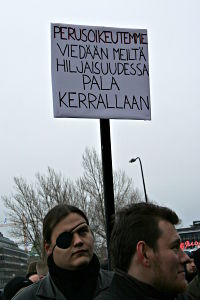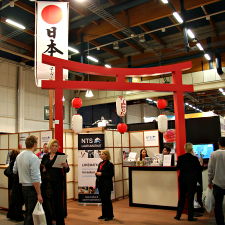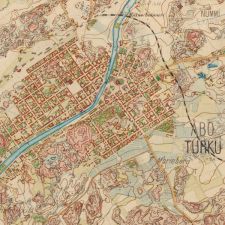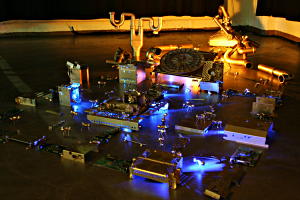Arto's Blog
Pages: << 1 ... 7 8 9 ...10 ...11 12 13 ...14 ...15 16 17 ... 27 >>
Privacy and Lex Nokia surveillance law
Posted: 2009-01-31 02:05:49, Categories: Finland, Helsinki, Politics, 484 words (permalink)
 Hand in hand with the introduction of new surveillance systems, methods and laws, personal right to privacy is eroding bit by bit. Latest addition in Finland is the law proposal dubbed as Lex Nokia (full text in Finnish). It has raised quite a few critical voices nationally and got some international attention through EDRI and articles in the Helsingin Sanomat newspaper international edition.
Hand in hand with the introduction of new surveillance systems, methods and laws, personal right to privacy is eroding bit by bit. Latest addition in Finland is the law proposal dubbed as Lex Nokia (full text in Finnish). It has raised quite a few critical voices nationally and got some international attention through EDRI and articles in the Helsingin Sanomat newspaper international edition.
In short, corporate and community Internet subscribers (yhteisötilaajat in Finnish) are about to gain substantial rights to monitor the behaviour of individual users in their networks. Publicly the law has been presented as a means to detect trade secret leaks from companies, but the proposal extends much further than that. For example libraries and university dormitories could check up on their users who they are exchanging emails with or which web pages they are visiting, with the broad excuse of suspicion of violation of network rules. The violation doesn't necessarily mean anything illegal, it is simply something which has been forbidden in the terms of use in that particular network.
There are some restrictions and privacy safeguards mentioned, but the proposal is written so unclearly that it's very difficult to say when exactly snooping would be allowed and when not. I tried but honestly couldn't figure it out. One thing is clear: the Finnish police is only allowed to browse the same kind of private information when the user is suspected of a crime, and minor crimes don't even apply. In other words, corporations and "community subscribers" are getting broader rights than the police. Oops.
There will be a public demonstration against the law proposal in Helsinki on February 5, 2009, starting at 14:30. If you agree with the message and can make it to the parliament house that day, be there! Another interesting related effort is creating two short TV commercials about the law and buying some prime time on one of the national channels to get the message out. The commercials will be aired a few times between Monday 2nd and Wednesday 4th of February.
There is something absurd about concerned private individuals campaigning against a surveillance law by buying airtime on television. Little by little, the world is being shaped towards the fictional reality described in George Orwell's famous book Nineteen Eighty Four (1984). His prediction was just a few dozen years ahead.
Update 17.2.2009: The TV commercials were aired and the public demonstration held, gathering about 300-400 participants. Discussion about the law proposal has continued lively in the media. The proposal has been criticized by the central bureau of police. The youth organization of the conservative party Kokoomus has issued a statement demanding the law proposal to be rejected. It will be interesting to see whether any of the conservative party members in power will follow their wish and vote against it. At least no politician can claim any more not having heard about problems related to the proposal.
Cheap flights and Japan at the Helsinki travel fair
Posted: 2009-01-26 21:53:49, Categories: Travel, Japan, Helsinki, Ecology, 445 words (permalink)
 The yearly Helsinki travel fair held during the third weekend of
January had a timely official theme: Vastuu yhteisestä maailmasta
(Responsibility of our common world). However, another
theme emerged more prominently: Fly far and cheap.
Finnair, Air France, KLM and other airlines had huge booths where they
were selling long distance flights for lower prices than ever.
Return flights to India, Thailand and China were less than 400 €,
to North America, Northern Africa and Japan well below 500 € and
to South American cities around 750 €, all taxes and other fees
included. With more than 85 000 visitors attending the event they
probably sold quite a few of them. I didn't really figure out how the
official and the unofficial theme connected with each other, but
never mind.
The yearly Helsinki travel fair held during the third weekend of
January had a timely official theme: Vastuu yhteisestä maailmasta
(Responsibility of our common world). However, another
theme emerged more prominently: Fly far and cheap.
Finnair, Air France, KLM and other airlines had huge booths where they
were selling long distance flights for lower prices than ever.
Return flights to India, Thailand and China were less than 400 €,
to North America, Northern Africa and Japan well below 500 € and
to South American cities around 750 €, all taxes and other fees
included. With more than 85 000 visitors attending the event they
probably sold quite a few of them. I didn't really figure out how the
official and the unofficial theme connected with each other, but
never mind.
I spent most of the time at the Japania ry booth, answering questions about traveling in Japan and Japanese cultural events in Finland. A typical visitor had just booked flights to Japan and was searching for hints about which places and cities are worth seeing, where to stay and other practical things. Another common category were fathers and mothers who came to ask about manga and anime (Japanese comics and animated films), because "our teenage kids are crazy about them and we don't understand anything".
Japanese youth culture is certainly hip in Finland now and it's a bit surprising that the Japanese Embassy doesn't do much to embrace it. Japan didn't have any official presence at the travel fair either, so Finnish-Japanese friendship organizations and a couple of travel agencies tried to fill the gap. Laatumatkat had a fancy torii (Shinto style gate) in front of their stand which is featured in the picture of this blog post. I also made a small photo gallery of Japan related stands at the event, including a few portraits of people in cosplay dresses (dressed as manga characters).
I tested a couple of booths with my favourite question What can you tell me about bicycle travel in your country?, but didn't meet anybody too enthusiastic or knowledgeable about it. Last year the Georgian representant did very well. :-) The narrow corridor where all the volunteer run friendship organizations were placed next to each other was again the best of the show: had a couple of nice discussions there. Otherwise I didn't find much of interest as I didn't want to book a cheap flight somewhere or collect a bunch of thick brochures. A bit too late I realized that I had missed the domestic section completely; that might have been worth visiting. For international travel, much better information is available through web sites and by contacting locals or other travel enthusiasts.
Change of the year greetings
Posted: 2008-12-23 12:29:10, Categories: General, Finland, Hospitality exchange, 297 words (permalink)
 I just published my 2008 Christmas and New Year card, available both
in Finnish
and in English.
I wish you happy holidays of the end of the year and even better new year 2009!
And for those readers who don't follow the Gregorian calendar or simply read
this later, happy current year and new year whenever it comes! :-)
I just published my 2008 Christmas and New Year card, available both
in Finnish
and in English.
I wish you happy holidays of the end of the year and even better new year 2009!
And for those readers who don't follow the Gregorian calendar or simply read
this later, happy current year and new year whenever it comes! :-)
This was already the second year I didn't buy any commercially available Christmas cards. Still, it's nice to occasionally send and receive not only email greetings but also good old fashioned paper mail. Letters reach also those relatives and friends who don't read email. Therefore I selected some photos taken during the year 2008, had them printed and wrote something personal at the back side of each one before mailing them out.
I plan to spend the Christmas with my family, as usual. We'll go to meet my mother's father at Pyhtää tomorrow on Christmas eve, staying at his home in the countryside until the following day. On the 26th we'll drive to Hyvinkää to visit my other grandfather. That's very common in Finland: Christmas is a family event and New Year is more often spent partying with friends.
One thing will be different this year: My youngest brother Lari will be missing. He moved to Canada a few months ago to study at a film school and decided to spend his holidays traveling in the U.S. and Canada. It was fun to plan Lari's Christmas present together with my parents: we're giving him "A Day in New York" — consisting of five addresses where he'll have something interesting to see or do, all costs covered of course. Once again I got help from CouchSurfing members, this time in the form of hints rather than accommodation.
New job on environmental and cultural data
Posted: 2008-12-03 22:42:23, Categories: General, Work, Finland, Free software, Literature, Politics, 865 words (permalink)
 My
half-time
work experiment felt good enough that I'm doing it again.
Same employer (CSC), 80 hours per
month contract until end of May 2009. This time I'm working on
services providing storage and access to environmental and cultural
data. There are opportunities to study topics I care about and
participate in making design choices, which makes the deal even more
attractive than last time.
My
half-time
work experiment felt good enough that I'm doing it again.
Same employer (CSC), 80 hours per
month contract until end of May 2009. This time I'm working on
services providing storage and access to environmental and cultural
data. There are opportunities to study topics I care about and
participate in making design choices, which makes the deal even more
attractive than last time.
Geographic information wants to be free
A lot of geographic information and data about natural resources is gathered around the world by governmental research institutes. The U.S. has been fairly open with providing access to such data while in Europe most institutes have been sitting on their databases and selling information with very restricted terms. Now the situation is slowly changing, partly due to an OECD recommendation which suggests open access to research data from public funding. The community maintained OpenStreetMap project has challenged closed models, and increasing popularity of partly open privately funded services such as Google Maps plays a role as well. The INSPIRE EU directive (see also the Ministry of Agriculture and Forestry INSPIRE page in Finnish) aims towards interoperability and sharing of geographical data, although its level of required openness falls behind the OECD recommendation.
In Finland, there's a lot of high quality data but it is scattered and little used outside the organizations collecting it. Many voices are raised in support of open access, for example in the Pätevä seminar two weeks ago. In practice progress is rather slow. The public research institutes are pointing towards the Ministry of Finance and the law about fees of public services (Maksuperustelaki) which their funding models are partly based on. Curiously, the key reason for fees in the law is to avoid causing harm to private companies competing in the same domain. However, many sources show (meteorology example) that business overall benefits from freely available public information. A fundamental change of government policy is needed in order to have open access by default also in Finland.
My first task in October was to contribute a little bit to a survey which reviews the current state of geographic information related data in Finland, and gives suggestions on what should be done. The survey focused on what data exists, how to make it available and usable for officials, researchers and politicians, and interoperability issues between different datasets. For example different coordinate systems and semantics are a big hindrance to cross analysis. I personally believe that increased openness will gradually help to improve lower level data compatibility as well. Fully open access raises strong opinions both in favor and against, but there seems to be a more general consensus that at least researchers should have convenient access to data.
(Added a link to the survey on geographic information related data on May 31, 2009)
Preserving cultural data for the next 100 years
Since beginning of November I'm participating in the National digital library project, which is about access, usability and long term preservation of Finnish cultural data. The Finnish National Archives and the National Library are digitizing old books, newspapers and other documents. In this case, open access gladly seems to be the default for at least old works whose copyrights have expired. You can already check out 18th and 19th century newspapers with full text search or municipal documents dating back until Middle Ages. The picture of this blog entry is part of a map of Turku in 1881, retrieved from the National Archives (see the full map). Several Finnish museums are also digitizing their collections. Many new documents, photos, movies and modern art works are already digital when they are created.
Preserving all this material reliably for tens and hundreds of years is a challenging task. The lifetime of computer and storage systems is around five or at most a couple of dozen years. Text in a paper book stays readable for centuries, but digital data will have to be continuously transferred to new, yet unseen storage systems. Current file formats and software to access them will become outdated over time. Human error or attack can have much greater impact in the digital archive than spilling coffee over one book in a physical library.
CSC does not take part in the digitization, but we are currently working on a preliminary requirements specification for the long term storage. Finland is not the first country thinking about it so there's a lot of material available. However, nobody has a complete and definitive solution to the problem yet. There are chances to do pioneering work and contribute to best practices also internationally.
On a personal level, I find projects on environmental and cultural data both very interesting. One challenge is where to focus energy in order to make a difference instead of getting lost between committee meetings and bureaucracy. Another challenge will be to keep work from ruling life, by reserving enough time for hobbies and rest. In November I already surpassed my 80 hours by 50%, not counting when work topics were in my thoughts during free time. However, that's still less than full time and I don't mind working hard if it feels important and rewarding. The half time contract has been a good starting point.
Diving into arts in Helsinki
Posted: 2008-10-31 01:08:50, Categories: Travel, Finland, Hospitality exchange, Helsinki, Literature, Movies, 730 words (permalink)
 When traveling, I'm breathing in a new environment every moment. In
Helsinki, I'm familiar with the surroundings and how the system
works. Part of that is easy access to information what is happening around. As a
result I end up going to more concerts, festivals and other cultural
events than during my travels.
When traveling, I'm breathing in a new environment every moment. In
Helsinki, I'm familiar with the surroundings and how the system
works. Part of that is easy access to information what is happening around. As a
result I end up going to more concerts, festivals and other cultural
events than during my travels.
The most interesting event happened through a CouchSurfing guest. I hosted Kevin who came from Berlin for the Helsinki Festival of New Juggling. The opening show was officially only for festival participants but the organizers kindly let me in with him. That was one and a half hours of most amazing juggling — in a nearby school gymnastics hall. :-) You could really feel the good vibes in the whole crowd. I also went to both public shows attached to the festival. The French group Compagnie Non Nova's Jongleur pas confondre on Saturday was a disappointment, but Ville Walo's and Kalle Hakkarainen's Puun syy was beautiful.
Love and Anarchy film festival took over the screens as usual in late September. The Icelandic comedy Astrópía offered the best laughs and was my favourite this year. Death Note came second by exploring the dark side of human mind in somehow very Japanese way. Some fans of the Death Note manga (comic) didn't appreciate the movie too much though. I should also mention the animation Nausicaä of the Valley of the Wind (Kaze no tani no Naushika) which is one of my favourite movies and comic books from all times. It was in the festival program, but as I had already seen the film and the hour of the screening was bad I skipped it this time.
Last weekend my friend Tuula came in Helsinki and we went together to the yearly book fair. Lectures were the most interesting part of the event. As adventurers and explorers in our own lives we both connected with the theme Vieraat kulttuurit suomalaisin silmin (Foreign cultures through Finnish eyes), and talks about happiness and personal choices in life. Marketta Horn told how she loved meeting people in the lively cheapest classes of trains during her travels in Asia and Australia. – Tän pitäis olla Kela-korvattavia asioita (This should be subsidized by the Finnish social security system), laughed Risto Lindstedt about the therapeutic value of his motorcycle travels. Parliament member and avid cyclist Osmo Soininvaara sitting besides him seemed to agree. – Hulluus tarjoaa helpotusta (Craziness offers relief), suggested Timo Airaksinen in his lecture. – Naisen sydän ei ole yhteensopiva nykymaailman kanssa. Voisiko hän muuttaa maailman sydämellisemmäksi? (The heart of a woman is not compatible with the modern world. Could she change the world into a more heartfelt one?), asked Hilkka Olkinuora, who touched the audience telling how women in particular submit too easily into the busy life expected by the society.
Tuula also joined me on Saturday to Alternative Party, where people come together to celebrate weird computers, music and funky digital arts. This year's event was bigger than ever but it had managed to preserve its friendly atmosphere. Front 242 did a great live concert on Friday night and Brad Templeton from Electronic Frontier Foundation was the guest of honor on Saturday. To my surprise Tuula also found the visit interesting and funny. She was probably more open minded towards the event than me. I realized how I had categorized Altparty as a nerd gathering which others wouldn't understand, and presented it as such.
During October I've also visited the Ateneum Art Museum, the Kiasma Museum of Contemporary Art and the Sinebrychoff Art Museum in Helsinki, plus Museum Centre Vapriikki in Tampere. It was a good reminder that museums are not static: all had plenty of new things to see. I particularly liked the Japanese wood prints in Ateneum and some works playing with light and colors in the Full House exhibition at Kiasma. Hint: Entrance to both Ateneum, Kiasma and Sinebrychoff Art Museum is free of charge on the first Wednesday of every month at 17-20 in the evening.
Settling down after the summer travels has been faster than it was after spending a whole year on the road. I've been meeting with friends, family and relatives, participating in club activities and spending countless hours reading and writing email, as usual. I also have a job again, but will write more about that later.
<< 1 ... 7 8 9 ...10 ...11 12 13 ...14 ...15 16 17 ... 27 >>

Copyright Arto Teräs <ajt@iki.fi>, licensed under the Creative Commons Attribution-Share Alike 3.0 Unported License. (Unless otherwise mentioned in individual photos or other content.)